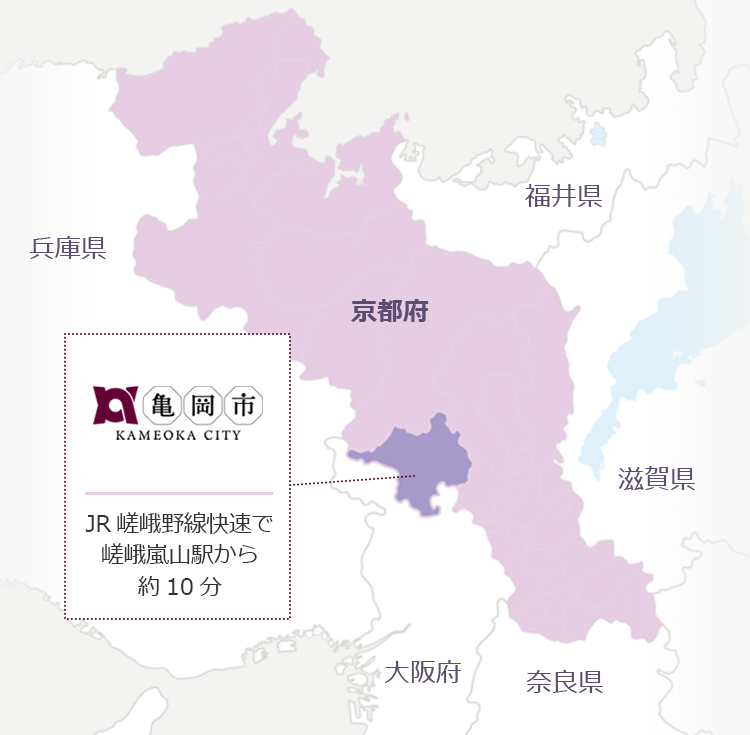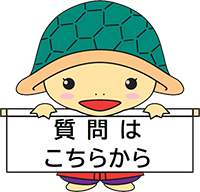本文
Weather Warnings 気象警報
- About Weather Warnings 気象情報について
- Types of Warning 特別警報の種類
- Types of Alerts 警報の種類
- Types of Advisories 注意報の種類
About Weather Warnings 気象情報について
The Japan Meteorological Agency (JMA) issues warnings and advisories in response to severe weather.
The JMA will contact prefectural/municipal governments to begin response measures and citizens will be contacted on a municipal level or through local media. Warnings and advisories will usually be broadcast on television and over radio, but you can also check for updates directly at the JMA homepage<外部リンク>.
Kameoka offers an information E-mail service. You can register for E-mail services online:
- Cell Phone: send an empty E-mail to [email protected]
- Computer: register at 亀岡市/かめおかメール情報配信サービス(English)<外部リンク>
※When a warning has been issued, schools and daycares may close for the day. Each school and daycare has a different policy so be sure to contact them directly if a warning is issued.
日本では、「気象庁」というところが天気や地震などの情報を集めます。天気予報の発表もしています。たとえば、大雨や台風などで危険になったとき、気象庁は「注意報」か「警報」を出します。
「注意報」や「警報」が出ると、その情報はテレビやラジオ、インターネットなどでみんなに伝えます。また、気象庁のホームページ<外部リンク>でも発表します。
亀岡市もメールでお知らせするサービスがあります。インターネットで登録できます。
- 携帯電話:[email protected]へ空メール(何も書いていないメール)を送ってください。
- パソコン:亀岡市/かめおかメール情報配信サービス<外部リンク>へアクセスしてください。
※「警報」が出ると、保育所や幼稚園、学校が休みになることがあります。住んでいるところや学校によって決まりが違いますから、確認してください。
Types of Warnings, Alerts and Advisories 特別警報、警報と注意報
Types of Warnings 特別警報の種類
There are 6 different types of weather warnings that the JMA will issue to alert people to possible weather related danger.
「警報」には6種類があります。
- Heavy Rain Warning 大雨特別警報 おおあめとくべつけいほう ōame tokubetsu keihō
A heavy rain warning will be issued when serious danger is anticipated from heavy rains that are expected to yield high rainfall amounts that is expected to be the worst in the last couple of decades due to typhoons or torrential rainfalls. It is also issued in the case of a strong typhoon or extratropical cyclone that is of a strength seen once in a couple of decades. Possibility of flooding and landslides are high. If there is still a chance of landslides occurring even after the rain has stopped, the warning will be continued.
台風や集中豪雨(しゅうちゅうごうう)で数十年に一度の降雨量(こううりょう)となる大雨が予想されるか、数十年に一度の強い台風や同じ温帯低気圧(おんたいていきあつ)で大雨になると予想されるときは、特別警報は発表します。家に水が入ってくることや、土砂災害が起る可能性がとても高いです。土砂災害は、たくさんの雨で、土や砂・石が流れることや山がくずれることを言います。雨が止んでも、まだ災害が起こる可能性が高いときは、警報はそのまま続きます。 - Heavy Snow Warning 大雪特別警報 おおゆきとくべつけいほう ōyuki tokubetsu keihō
A heavy snow warning will be issued when serious danger is anticipated from heavy snowfall that is expected to be one of the worst in the last couple of decades.
たくさん雪が降ることを大雪と言います。数十年に一度の大雪で大変危険なとき、この特別警報が出ます。 - Strong Wind Warning 暴風特別警報 ぼうふうとくべつけいほう bōfū tokubetsu keihō
A strong wind warning will be issued when serious danger is anticipated from strong winds due to a strong typhoon or extratropical cyclone that is expected to be one of the worst in the last couple of decades.
とても強い風のことを暴風と言います。数十年に一度の強い台風や同じ温帯低気圧(おんたいていきあつ)での暴風で大変危険なとき、この特別警報が出ます。 - Blizzard Warning 暴風雪特別警報 ぼうふうせつとくべつけいほう bōfūsetsu tokubetsu keihō
A blizzard warning will be issued when serious danger is anticipated from very strong winds accompanied by heavy snowfall due to a strong typhoon or extratropical cyclone that is expected to be one of the worst in the last couple of decades..
とても強い風が吹いて、雪もたくさん降っていることを暴風雪と言います。数十年に一度の強い台風や同じ温帯低気圧(おんたいていきあつ)での暴風雪で大変危険なとき、この特別警報が出ます。 - Heavy Seas Warning 波浪特別警報 はろうとくべつけいほう harō tokubetsu keihō
A heavy seas warning will be issued when serious danger is anticipated from high waves due to a strong typhoon or extratropical cyclone that is expected to be one of the worst in the last couple of decades.
波浪は、海の波ということです。数十年に一度の強い台風や同じ温帯低気圧(おんたいていきあつ)で海が荒いときにこの特別警報が出ます。海から離れてください。 - Flood Tide Warning 高潮特別警報 たかしおとくべつけいほう takashio tokubetsu keihō
A flood tide warning will be issued when serious danger is anticipated from an unusual rise in sea level due to a strong typhoon or extratropical cyclone that is expected to be one of the worst in the last couple of decades..
数十年に一度の強い台風や同じ温帯低気圧(おんたいていきあつ)で潮が高いときにこの特別警報が出ます。海から離れてください。
Types of Alerts 警報の種類
There are 7 different types of weather alerts that the JMA will issue to alert people to possible weather related danger.
「警報」には7種類があります。
- Heavy Rain Alert 大雨警報 おおあめけいほう ōame keihō
A heavy rain alert will be issued when serious danger is anticipated from heavy rains, such as flooding or landslides. If there is still a chance of landslides occurring even after the rain has stopped, the warning will be continued.
たくさんの雨が降ることを大雨と言います。大雨で大変危険なとき、この警報が出ます。家に水が入ってくることや、土砂災害が起こるかもしれないときです。土砂災害は、たくさんの雨で、土や砂・石が流れることや山がくずれることを言います。雨が止んでも、まだ災害が起こるかもしれないときは、警報はそのまま続きます。 - Flood Alert 洪水警報 こうずいけいほう kōzui keihō
A flood alert will be issued when serious danger is anticipated from rivers overflowing with snowmelt, heavy rains, or continuous rain. When only a specific river is considered in danger of overflowing, a "specified river flood warning" (特定河川洪水警報 tokutei kasen kōzui keihō) will be issued instead.
川の水があふれることを洪水と言います。大雨や長い時間雨が降るときや、雪が解けたときなど、川の水が増えます。あふれたら危険です。そんなときに、この警報が出ます。どの川が危ないか、発表することもあります。そのとき、特定河川洪水警報(とくていかせんこうずいけいほう)」が出ます。 - Heavy Snow Alert 大雪警報 おおゆきけいほう ōyuki keihō
A heavy snow alert will be issued when serious danger is anticipated from heavy snowfall.
たくさん雪が降ることを大雪と言います。大雪で大変危険なとき、この警報が出ます。 - Strong Wind Alert 暴風警報 ぼうふうけいほう bōfū keihō
A strong wind alert will be issued when serious danger is anticipated from strong winds.
とても強い風のことを暴風と言います。暴風で大変危険なとき、この警報が出ます。 - Blizzard Alert 暴風雪警報 ぼうふうせつこうほう bōfūsetsu keihō
A blizzard alert will be issued when serious danger is anticipated from very strong winds occurring with heavy snowfall. This includes not only damage from the build-up of snow, but also from loss of visibility due to snowfall. If danger is anticipated not from "heavy snowfall accompanied by very strong winds," but only from "heavy snowfall," the JMA will issue a heavy snow warning (大雪警報 ōyuki keihō)
とても強い風が吹いて、雪も降っていることを暴風雪と言います。暴風雪で大変危険なとき、この警報が出ます。風が強くて、たくさん雪が降ると、前がよく見えなくなります。注意してください。 - Heavy Seas Alert 波浪警報 はろうけいほう harō keihō
A heavy seas alert will be issued when serious danger is anticipated from high waves. This is not to be confused with a tsunami warning (津波警報 tsunami keihō). A tsunami is a high wave that is caused by an earthquake.
波浪は、海の波ということです。海が荒いときにこの警報が出ます。海から離れてください。波浪警報は津波警報と違います。津波は地震の後に起きます。 - Flood Tide Alert 高潮警報 たかしおけいほう takashio keihō
A flood tide alert will be issued when serious danger is anticipated from an unusual rise in sea level due to a typhoon or low air pressure system.
潮が高いときにこの警報が出ます。海から離れてください。
Types of Advisories 注意報の種類
There are 16 different types of advisories that the JMA will issue to alert people to possible weather related danger.
「注意報」には16種類があります。
- Heavy Rain Advisory 大雨注意報 おおあめちゅういほう ōame chūihō
A heavy rain advisory will be issued when danger is anticipated from heavy rains, such as flooding or landslides. If there is still a chance of landslides occurring even after the rain has stopped, the advisory will be continued.
たくさんの雨が降ることを大雨と言います。大雨で危ないとき、災害が起こるかもしれないとき、この注意報が出ます。家に水が入ってくるや、土砂災害が起こるかもしれないときです。土砂災害は、たくさんの雨で、土や砂・石が流れることや山が崩れることを言います。雨がやんでも、まだ災害が起こるかもしれないときは、注意報はそのまま続きます。 - Flood Advisory 洪水注意報 こうずいちゅういほう kōzui chūihō
A flood advisory will be issued when danger is anticipated from rivers overflowing from snowmelt, heavy rains, or continuous rain. When only a specific river is considered to be in danger of overflowing, a "specified river flood warning" (特定河川洪水注意報 tokutei kasen kōzui chūihō) will be issued instead.
川の水があふれることを洪水と言います。大雨や長い時間雨が降ったときや、雪が融けたときなど、川の水が増えて、危ないです。そんなときに、この注意報が出ます。どの川が危ないか、発表することもあります。そのとき、特定河川洪水注意報(とくていかせんこうずいちゅういほう)」が出ます。 - Heavy Snow Advisory 大雪注意報 おおゆきちゅういほう ōyuki chūihō
A heavy snow advisory will be issued when danger is anticipated from heavy snowfall.
たくさん雪が降ることを大雪と言います。大雪で危ないとき、この注意報が出ます。 - Strong Winds Advisory 強風注意報 きょうふうちゅういほう kyōfū chūihō
A strong wind advisory will be issued when danger is anticipated from strong winds.
強い風のことを強風と言います。強い風で危ないとき、この注意報が出ます。 - Snowstorm Advisory 風雪注意報 ふうせつちゅういほう fūsetsu chūihō
A snowstorm advisory will be issued when danger is anticipated from snowfall accompanied by strong winds. This includes not only danger from the build up of snow, but also from loss of visibility due to snowfall. If danger is anticipated not from "heavy snowfall accompanied by strong winds," but only from "heavy snowfall," the JMA will issue a "heavy snow advisory" (大雪注意報 ōyuki chūihō) instead.
強い風が吹いて、雪も降っていることを風雪と言います。風と雪で危ないとき、この注意報が出ます。風が強いことはもちろん、たくさん雪が降ると、前が見えなくなります。注意してください。 - Heavy Seas Advisory 波浪注意報 はろうちゅういほう harō chūihō
A heavy seas advisory will be issued when danger is anticipated from high waves. This is not to be confused with a tsunami advisory (津波注意報 tsunami chūihō). A tsunami is a massive wave that is caused by an earthquake.
波浪は、海の波ということです。海が荒いときにこの注意報が出ます。海から離れてください。波浪注意報は津波注意報と違います。津波は地震の後に起きます。 - Flood Tide Advisory 高潮注意報 たかしおちゅういほう takashio chūihō
A flood tide advisory will be issued when danger is anticipated from an unusual rise in sea level due to a typhoon or low air pressure system.
潮が高いときにこの注意報が出ます。海から離れてください。 - Heavy Fog Advisory 濃霧注意報 のうむちゅういほう nōmu chūihō
A heavy fog advisory will be issued when danger is anticipated from heavy fog, including transportation systems operating in low visibility conditions.
濃い霧で危ないとき、この注意報が出ます。霧が出て、前が見えないくなるため、バスや電車が遅れることがあります。止まることもあります。 - Thunderstorm Advisory 雷注意報 かみなりちゅういほう kaminari chūihō
A thunderstorm advisory will be issued when danger is anticipated from lightning. Also, a thunderstorm advisory indicates a danger of sudden heavy rains, hail, or strong winds.
雷で危ないとき、この注意報がでます。雷雲(雷や強い雨をもたらす雲)が出ると、突然強い風が吹きます。「ひょう」が降ることもあります。また、急に強い雨が降るかもしれないときも、この注意報が出ます。 - Dry Weather Advisory 乾燥注意報 かんそうちゅういほう kansō chūihō
A dry weather advisory will be issued when danger is anticipated from dry weather. In general this indicates a danger of fire caused by periods of extended dryness.
空気が乾くと火事が起きやすくなります。そんなとき、この注意報が出ます。 - Avalanche Advisory なだれ注意報 なだれちゅういほう nadare chūihō
An avalanche advisory will be issued when danger is anticipated from snow slides from the mountains.
山にたくさん積もった雪が、突然落ちてくることをなだれと言います。「なだれ」で危ないとき、この注意報が出ます。 - Ice Advisory 着氷注意報 ちゃくひょうちゅういほう chakuhyō chūihō
An ice advisory will be issued when danger is anticipated from an unusual buildup of ice. In general this indicates the possiblity of damage to telephone and electric wires, as well as to the bodies of ships, etc.
道や電線、船などが凍って、危ないとき、この注意報が出ます。 - Snow Accumulation Advisory 着雪注意報 ちゃくせつちゅういほう chakusetsu chūihō
A snow accumulation advisory will be issued when danger is anticipated from an unusual buildup of snow. In general, this indicates the possibility of damage to telephone and electric wires, as well as to the bodies of ships, etc.
道や電線、船などにたくさん雪が積もって、危ないとき、この注意報が出ます。 - Snowmelt Advisory 融雪注意報 ゆうせつちゅういほう yūsetsu chūihō
A snowmelt advisory will be issued when danger is anticipated from the melting of a large amount of snow. In general this indicates flood damage and a danger of landslides.
雪が解けることを融雪と言います。雪が解けて、土砂災害(土や砂・石が流れてくること)が起こるかもしれないときや、川があふれるかもしれないとき、この注意報が出ます。 - Frost Advisory 霜注意報 しもちゅういほう shimo chūihō
A frost watch will be issued when danger is anticipated from the formation of frost. In general, this indicates damage to crops from sudden frost buildup or an overnight frost.
霜で農作物が悪くなるかもしれないとき、この注意報が出ます。 - Low Temperature Advisory 低温注意報 ていおんちゅういほう teion chūihō
A low temperature advisory will be issued when danger is anticipated from low temperatures. In general, this indicates damage to crops or the possiblity of frozen or burst pipes.
気温がとても低くなると、農作物が悪くなります。水道管が凍って壊れることもあります。そんなとき、この注意報が出ます。
For more information, please visit the JMA website(English)<外部リンク>
もっと詳しい情報を知りたいとき<外部リンク>





